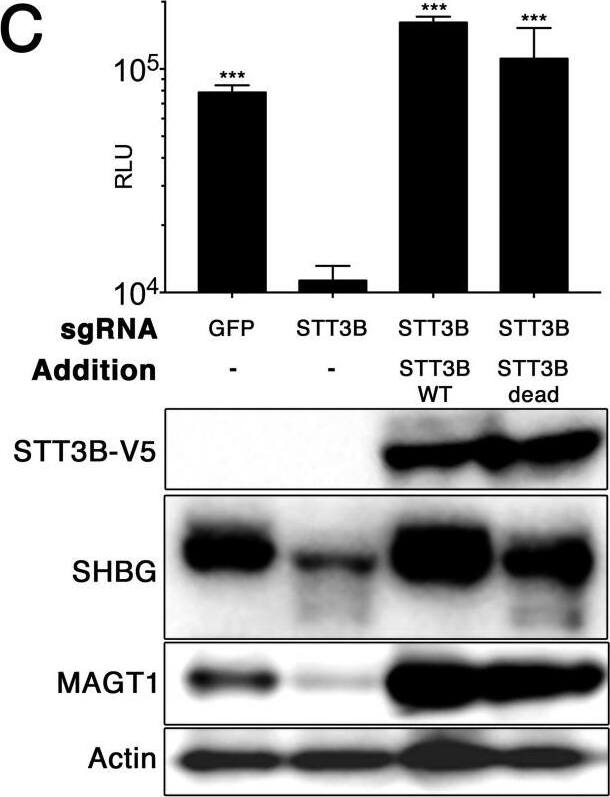Human SHBG Antibody
R&D Systems, part of Bio-Techne | Catalog # MAB2656

Key Product Details
Validated by
Species Reactivity
Validated:
Cited:
Applications
Validated:
Cited:
Label
Antibody Source
Product Specifications
Immunogen
Leu30-His402
Accession # P04278
Specificity
Clonality
Host
Isotype
Scientific Data Images for Human SHBG Antibody
Human SHBG ELISA Standard Curve.
Recombinant Human SHBG protein was serially diluted 2-fold and captured by Mouse Anti-Human SHBG Monoclonal Antibody (Catalog # MAB2656) coated on a Clear Polystyrene Microplate (Catalog # DY990). Mouse Anti-Human SHBG Monoclonal Antibody (Catalog # MAB2656) was biotinylated and incubated with the protein captured on the plate. Detection of the standard curve was achieved by incubating Streptavidin-HRP (Catalog # DY998) followed by Substrate Solution (Catalog # DY999) and stopping the enzymatic reaction with Stop Solution (Catalog # DY994).Detection of Human SHBG by Western Blot
The catalytic activities of STT3A or STT3B are not required for DENV replication. (A) Huh7.5.1 cells were transduced with a lentivirus encoding a puromycin resistance marker, Cas9, and a single guide RNA (sgRNA) targeting the indicated genes. The sgRNAs targeting GFP act as a negative control. Two independent sgRNAs (indicated by 1 or 2 below the bars in the bar graph) were used per target gene to generate knockout cell pools. Cells were infected with luc-DENV for 3 days, and luciferase activity was measured in relative light units (RLU). Western blots for the indicated proteins are shown below the bar graph. Arrows indicate nonspecific bands. (B and C) Knockout cell pools were transduced with lentiviral vectors to rescue expression of the indicated protein. “STT3A dead” is a catalytically inactive W526A D527A double mutant. “STT3B dead” is a catalytically inactive W605A D606A double mutant with a C-terminal V5 tag. Transient transfection of constructs to express pSAP and SHBG were used to assess STT3A and STT3B catalytic activity. Western blots below the bar graph show the expression of the indicated proteins. wt and WT, wild type. (D) Knockout cell pools were transiently transfected with a luc-DENV replicon, and luciferase activity was measured at 4 h, 48 h, and 72 h posttransfection (hpt). Data are plotted as a ratio of RLU to the RLU at 4 hpt to control for transfection efficiency. GDD indicates a polymerase dead replicon with replacement of the GNN active site sequence in the NS5 RNA polymerase by GDD. (E) Cell viability for knockout cell pools was measured by Cell-Titer Glo over the course of 4 days for three independent wells. Data are normalized to day 1 values. The values for the parental Huh7.5.1 cells (P) are shown. In panels A to E, data are expressed as means plus standard deviations (SD) (error bars) for three independent biological replicates. In panels A to D, statistical significance was determined by Student’s t test and indicated by asterisks as follows: *, P < 0.05; **, P < 0.005; ***, P < 0.0005. In panel A, the means were compared to the mean for GFP sgRNA 2. In panels B and C, the means were compared to the means of their respective knockouts. In panel D, the means were compared to the mean for the GFP control. Image collected and cropped by CiteAb from the following publication (https://pubmed.ncbi.nlm.nih.gov/28720733), licensed under a CC-BY license. Not internally tested by R&D Systems.Applications for Human SHBG Antibody
ELISA
This antibody functions as an ELISA capture antibody when paired with Mouse Anti-Human SHBG Monoclonal Antibody (Catalog # MAB2656).
This product is intended for assay development on various assay platforms requiring antibody pairs. We recommend the Human SHBG DuoSet ELISA Kit (Catalog # DY2656) for convenient development of a sandwich ELISA.
Reviewed Applications
Read 2 reviews rated 5 using MAB2656 in the following applications:
Formulation, Preparation, and Storage
Purification
Reconstitution
Formulation
Shipping
Stability & Storage
- 12 months from date of receipt, -20 to -70 °C as supplied.
- 1 month, 2 to 8 °C under sterile conditions after reconstitution.
- 6 months, -20 to -70 °C under sterile conditions after reconstitution.
Background: SHBG
Human Sex Hormone Binding Globulin (SHBG), also known as ABP or androgen binding protein, is a variably glycosylated, secreted non-disulfide linked homodimer that belongs to the SHBG family. Members of this small family have tandem repeats of 170 aa long laminin a chain G-like domains. Each SHBG monomer is a 47-53 kDa, 373 aa glycoprotein that contains one steroid-binding site in its N-terminal G-like domain. Male and female sex hormones are bound with equal affinity. SHBG is synthesized by the liver and circulates in blood; ABP (SHBG in the testis) is synthesized by Sertoli cells and circulates in the male reproductive system. Human SHBG shares approximately 67% aa sequence identity with mouse and rat SHBG.
Long Name
Alternate Names
Entrez Gene IDs
Gene Symbol
UniProt
Additional SHBG Products
Product Documents for Human SHBG Antibody
Product Specific Notices for Human SHBG Antibody
For research use only

